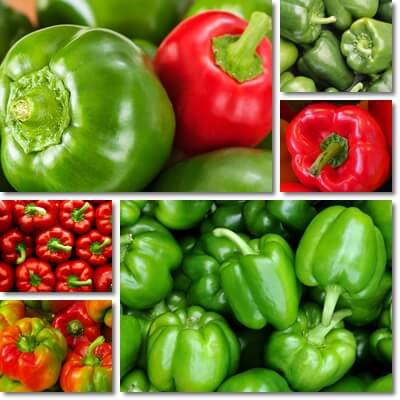The biggest, most obvious difference between green and red bell peppers is color. The difference in color aptly indicates the two fruits are at different ripening stages: green bells are unripe, whereas red ones are ripe. Both colors are actually the same botanical fruit: the bell pepper (scientific name: Capsicum annuum). But they are not necessarily the exact same fruit cultivar, or cultivated variety. That is, while all red bell peppers are green first, only some green bell peppers will turn red when they ripen, while others will turn orange, purple, yellow, black, white or chocolaty or even stripey. And each color indicates the presence of different antioxidant compounds and essential vitamins in the fruit, leading to varying health effects, benefits, uses and side effects.
Are all green bell peppers unripe?
Yes, pretty much all green bell peppers are unripe. Green is usually the color of unripe fruit. Even red bell peppers are green first, when they’re unripe. The green color is commonly owed to a pigment and antioxidant called chlorophyll. When chlorophyll starts to break down in the fruit, a change in color occurs, signaling fruit ripening. When green bell peppers are fully ripe, they turn any other color except for green. Some turn red, some yellow, some orange, some purple or black, some yellow with red stripes and so on. The color of the bell pepper fruit at maturity is determined by the cultivar, or the cultivated variety of the fruit.

Are red bell peppers just ripe green bell peppers?
All red bell peppers are ripe green bell peppers. As the fruits start to ripen, the chlorophyll pigment responsible for the green color starts to break down, initiating the change in color that makes them turn red. Along with the change in color come changes in taste and nutritional status, namely vitamin, mineral and antioxidant profile. Typically, at their ripest, bell peppers will have more of most essential vitamins and dietary minerals, as well as higher amounts of certain antioxidants. This is also why green, yellow, orange, red bell peppers and other colors are not the exact same thing, despite being the same fruit, botanically speaking.
Differences: nutrition facts
Both colors are healthy foods and provide equally important nutrition and similar health benefits, but do exhibit some differences in nutritional value. For example, red bell peppers have more vitamin A, more vitamin C, 3 times more vitamin B2 (riboflavin), double the content of vitamin B3 (niacin), 3 times the vitamin B5 (pantothenic acid) and about 4.5 times the content of vitamin B9 (folate). Versus green bell peppers which have one third more vitamin K. Choline content is fairly similar. Differences in mineral content are not very significant; the overall mineral content is low (around 5% of daily requirements from servings of 100 g of the fruit), not to mention dependent on soil quality since the fruits draw minerals from the soil.
Differences: antioxidant profile
In terms of antioxidants, green bell peppers are different from red. The green color in green bell peppers comes from chlorophyll, the same antioxidant that gives green algae, kelp and other seaweed, spinach, parsley, beet greens, dandelion greens, turnip tops and other green leafy vegetables their color. Versus the red color in red bell peppers which comes from carotenoid antioxidants, mainly carotenes such as beta-carotene, but also alpha-carotene, beta-cryptoxanthin and more.

List of differences
- Ripeness: Green bell peppers are unripe, while red ones are ripe.
- Taste: Green bells are bitter, while red are sweet. Both have strong, non-pungent or non-spicy peppery flavors.
- Pigments: The green color comes from chlorophyll, versus the red which comes from carotenoids, mainly carotenes such as beta-carotene, alpha-carotene, but also xanthophylls such as beta-cryptoxanthin, lutein, zeaxanthin and others.
- Antioxidants profile: Green bell peppers have chlorophyll, carotenoids in the form of xanthophylls (beta-cryptoxanthin, lutein and zeaxanthin) and carotenes (alpha and beta-carotene), vs red bell peppers which have carotenoids in the form of carotenes (alpha-carotene, beta-carotene), but also xanthophylls (beta-cryptoxanthin, lutein, zeaxanthin). Both colors have the antioxidant vitamins A, C and E, the antioxidant minerals copper, iron and manganese and other polyphenols.
- Antioxidants content: Green bell peppers are higher in chlorophyll, lutein and zeaxanthin (341 micrograms/100 g), but lower in beta-carotene (208 micrograms/100 g) and beta-cryptoxanthin (only 7 micrograms). Versus red which are higher in beta-carotene (1624 micrograms/100 g), beta-cryptoxanthin (490 micrograms/100 g), but lower in lutein and zeaxanthin (51 mcg/100 g). Alpha-carotene content is about the same (21 vs 20 micrograms/100 g).
- Vitamin A content: Green bell peppers are lower in vitamin A, providing only 18 micrograms of vitamin A from carotene antioxidants per 100 g, or 2% of the recommended daily intake (RDI) of the vitamin for the average adult. Versus red bell peppers which are a lot higher in vitamin A, with 157 micrograms of vitamin A per 100 g, or 17.5% of RDI.
- Vitamin K content: Green bells have about 30% more vitamin K, providing 7.4 micrograms of vitamin K per 100 g (7% of daily requirements), versus red which have 4.9 micrograms of vitamin K per 100 g.
- Vitamin C content: A serving size of 100 g of raw green bell peppers provides 80.4 milligrams of vitamin C (the equivalent of 97% of the recommended daily intake for an average adult), versus red bell peppers which have 127.7 milligrams of vitamin C per 100 g, making them a better source of the vitamin.
- B vitamins (per 100 g): There is roughly 3 times more vitamin B2 in red vs green bell peppers (0.085 milligrams vs 0.028 milligrams), double the vitamin B3 (0.979 mg vs 0.480 mg), 3 times the vitamin B5 content (0.317 mg vs 0.099 mg), a little more vitamin B6 (0.291 mg vs 0.224 mg), 4.5 times the vitamin B9 content (46 micrograms vs 10 micrograms) and 4.2 times the vitamin E content (1.58 micrograms vs 0.37 micrograms). And about 1.8 more grams of carbs and sugar.
- Mineral content per 100 g (green vs red): Calcium (7 mg vs 10 mg), Copper (0.066 mg vs 0.017 mg), Iron (0.34 mg vs 0.43 mg), Magnesium (10 mg vs 12 mg), Manganese (0.122 mg vs 0.112 mg), Phosphorus (20 mg vs 26 mg), Potassium (175 mg vs 211 mg), Sodium (3 mg vs 4 mg), Zinc (0.13 mg vs 0.25 mg).
- Side effects: Both red and green bell peppers are known to cause side effects such as acid reflux, heartburn, bloating, burping, stomach pain and are bad foods to eat for gastritis, GERD and even IBS. But green ones are likely worse.
- Benefits: Both colors provide the same range of health benefits, but red bell peppers are particularly good for vision, skin and the nervous and immune system as a result of being higher in vitamins A, C, B2, B3, B5, B6 and B9.
